Warsaw - page 1
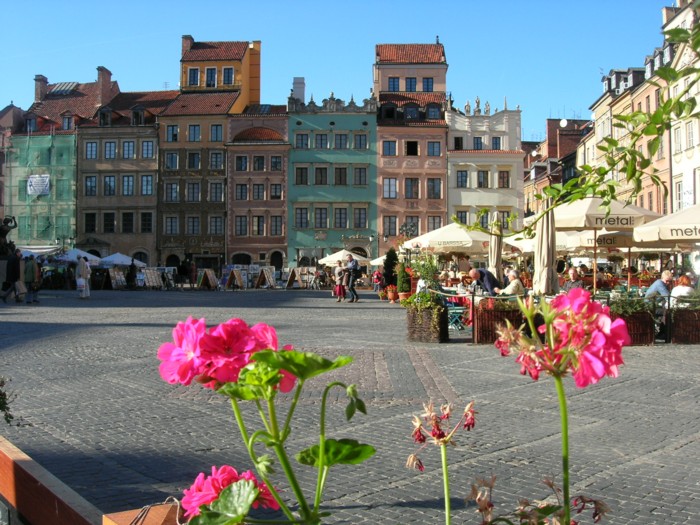
Warsaw. The Old Town Square. – Photo by: Jakob Hoffmann
Contents for Warsaw:
Warsaw – page 1 .
Warsaw – page 2
Warsaw – page 3
Warsaw – page 4
Warsaw – page 5
Warsaw – page 6
Warsaw – page 7
Warsaw – page 8
Warsaw – page 9
Distance
Population
1.708.000 (2011)
1 777 972 (2018)
Location and history
Warsaw is Poland’s capital and the country’s largest city. The city is a hub of the country, not only administratively, but also in terms of culture, education and business.
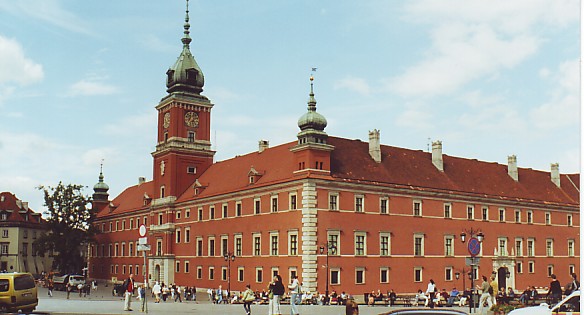
Warsaw Royal Palace
History:
The first settlement around present-day Warsaw dates to the 10th century. During the year 1262, a Russian chronicle mentions the burning of the Mazowsze princes’ tree-built castle in Jazdów, at the site of the Botanical Garden, and near Ujazdów Castle. Jazdów was again conquered and plundered in 1281. At the end of the 13th century. a few miles north of Jazdów, where the Royal Palace now stands, a new princely fortification, the present Warsaw, was erected.
Warsaw is mentioned for the first time in a document from 1313. In 1339, in Warsaw, located in the neutral principality of Mazowsze, a papal court was set up to rule in a case between Kazimierz the Great and the Crusaders concerning the wrongful taking of East Pomerania (Pomorze Gdańskie) which belonged to Poland. Under Prince Janusz In the older (1374-1429) who did much for the city, the centers of the Principality of the Principality were moved from Czersk to Warsaw, thus by Warsaw from 1406 and formally from 1413 was the capital of Mazowsze.
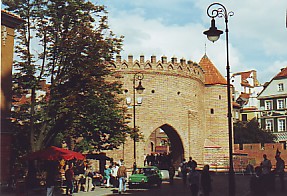
The Barbakan Fortress at the Old Town’s northern city gate
After the last princes of Mazowsze were dead childless, Warsaw as well as the entire Mazowsze region became the property of the Polish kings. In 1526 King Zygmunt the Old entered Warsaw, and from that point onwards, this king and his son Zygmunt August (of the Jagiełło dynasty) allowed more and more governmental cases to be dealt with in the castle of Warsaw. Zygmunt the grandson of the Old, King Zygmunt III Waza (of the Swedish Vasa genealogy), decided in 1596 – because of a great fire on the royal castle in Kraków and because of Warsaw’s more central location in relation to the territory of the Polish-Lithuanian dual state – to move the state offices to Warsaw. However, the decision on Warsaw as the new capital was implemented slowly and gradually.
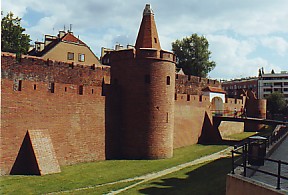
The city wall around the Old City
The development of the city and the growth of its population were hampered by the Swedish wars and other wars in the middle of the 17th and early 18th centuries. The greatest development of the city is due to the last Polish king, Stanisław August Poniatowski, as the city grew dynamically in his time and became a modern urban organism, a center of political and economic life, the country’s trade and industry and national center of the Polish Enlightenment. The National Theater (Teatr Narodowy) arose in 1765 at the king’s initiative. During the same period, Warsaw received a number of buildings and residences, usually in Stanisław August’s style – a specific Polish variant of early classicism. Among other things, the castle was built in ienazienki, just as the park was planned here. The interior of the royal palace was remodeled. The so-called Stanisław axis was cut off; it was an extensive urban and park complex, comprising an avenue that went from the Ujazdów castle (Zamek Ujazdowski) to the west to the system of the so-called “star places” Plac Na Rozdrożu, Plac Zbawiciela and Plac Unii Lubelskiej).
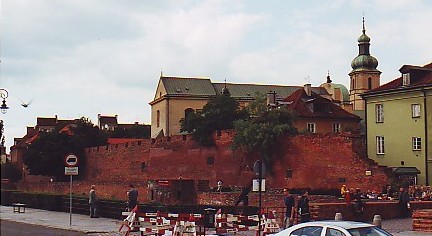
Ruins of the old city wall near Castle Square
After Poland’s third division in 1795, part of Mazowsze Prussia, including Warsaw, which was at the same time degraded to provincial city, fell. In July 1807, during the peace in Tilsit during the Napoleonic Wars, the Principality of Warsaw (Księstwo Warszawskie) was created. Warsaw again became an active center of political and cultural life. Napoleon’s defeat, however, meant the end of the Principality.
After the Vienna Congress in 1815, Warsaw became the capital of the Polish Kingdom (Królestwo Polskie), which depended on Russia, but which for a number of years was able to maintain quite considerable autonomy. During this period, effective urban planning and scientific life happened. A new road wound – Aleje Jerozolimskie – was constructed, and an attempt was made to homogenize the construction on the city’s main street, such as at Nowy Świat. The Society of Friends of Science began its business during this time. However, cultural development was hampered by the strict censorship and secret police interference, led by the great prince Constantine.
Following the November uprising in 1830, Warsaw experienced a brief period of independence. But the collapse of the uprising meant the dismantling of the constitutional special status of the kingdom. Sejm (parliament) ceased to exist and so did the government and the Polish army. The university was closed down and associations were banned. At the Citadel (Cytadela), built 1832-34 after the demolition of an entire neighborhood on the site, the dreaded investigative commission to keep the rebellious Warsaw empty. Cultural life gradually assumed an unofficial and informal character.
In the years 1840-48 the first railway line arose between Warsaw and Vienna.
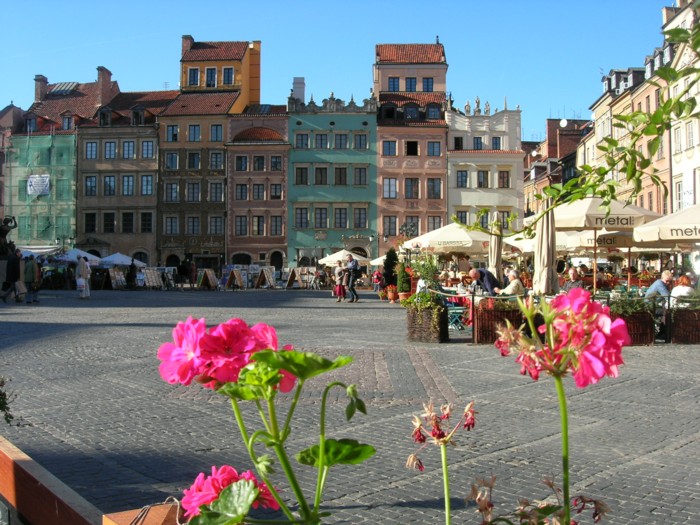
The Old Town Square. – Photo by: Jakob Hoffmann
After the January uprising (1863), in 1864, the last remnant of the kingdom’s autonomy was removed. Strict Russification of schooling and administration was carried out.
However, the city developed despite the unfavorable political conditions. The industry was expanded.
In 1915, during World War I, the city came under German occupation. In 1918, Warsaw became the capital of reborn Poland, which became a reality after the end of the war. As early as 1916, a plan was developed for the expansion of Greater Warsaw. After the war, new traffic arteries were built, and modern living quarters emerged. Żoliborz, Mokotów and Saska Kępa.
The capital’s development was interrupted by World War II and the German occupation. The defense of the beleaguered Warsaw continued until September 28, 1939. The city then became – as so often in times of turmoil and disobedience – a center for the resistance movement and a center for the secret cultural and scientific life.
In April 1943, a revolt was launched in the Jewish ghetto. The insurgency was fought and the ghetto eradicated. The entire Jewish quarter, which numbered half a million people, ceased to exist.
On August 1, 1944, the Warsaw Uprising, prepared by the underground army, Armia Krajowa, erupted. On October 2, the rebels had to sign a surrender declaration. Following the defeat of the uprising, Warsaw was sentenced to destruction. The population was driven out of town and taken to concentration camps. The Germans planned a general demolition of the city. The losses resulting from the destruction of the city by the Germans were enormous and difficult to assess; these are material and cultural losses, including burnt libraries and museums as well as castles and churches. In addition, the human losses. Ca. 650 thousand people perished. Most of the city was laid in ruins.Ca. 84 percent of the buildings were destroyed. German special forces burned down after a deliberate plan house after house, street after street and especially valuable buildings. The royal palace was blown up.
Immediately after the end of the war, in 1945, the enormous reconstruction and reconstruction work began.
Translated into English by Google Translate. Spangshus.dk accept no liability for any errors or omissions in translation.
Map

Rating
Search
Most used tags
churches (205) Castles (86) Monasteries (79) Town walls (74) Lakes (71) Town halls (67) Rivers (65) Castles1 (62) Mansions (55) Museums (51) Regional museums (38) Town gates (36) Abbey churches (35) Castle ruins (30) Cathedrals (26) Forests (25) Health resorts (24) Mounds (23) Water sports (23) National parks (22)Click for all tags
Denne side er også tilgængelig på dansk. This page and contents is (c) Copyright 2018- www.spangshus.dk. Based on Inviator software by ISCA Software